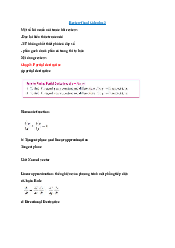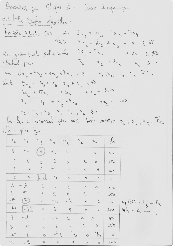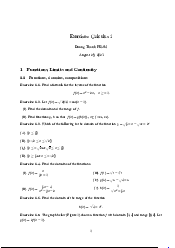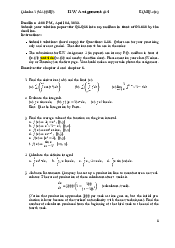

Preview text:
Chapter 1 Straight line
Translation from f(x), c >0
Stretches and reflection 𝑦𝑦2−𝑦𝑦1 Left
𝑓𝑓(𝑥 𝑥 + 𝑐𝑐) Stretch vertically
𝑐𝑐𝑓𝑓(𝑥𝑥) • Slope: m = = tan α 𝑥𝑥2−𝑥𝑥1 Right
𝑓𝑓(𝑥𝑥 − 𝑐𝑐) Compress horizontally
𝑓𝑓(𝑐𝑐𝑥𝑥)
• Slope - intercept form: y = mx +b Up 𝑓𝑓(𝑥𝑥) + 𝑐𝑐 Reflect x – axis −𝑓𝑓(𝑥𝑥)
• Point - slope form: y – y1 = m (x – x1) Down
𝑓𝑓(𝑥𝑥) − 𝑐𝑐 Reflect y - axis 𝑓𝑓(−𝑥𝑥)
Graph of common function: • Power: • Exponential: • Trigonometric: • Logarithmic:
Composition: 𝑓𝑓𝑓𝑓𝑓𝑓 = 𝑓𝑓(𝑓𝑓(𝑥𝑥) )
Squeeze theorem: if f(x) ≤ g(x) ≤ h(x) ∀x in an open interval containing xo, One to one: f(x
𝑓𝑓 𝑥𝑥 = ℎ 𝑥𝑥 = L ⇒ 𝑓𝑓 1)≠ f(x2) whenever x1≠x2 and if lim ( ) lim( ) lim (𝑥𝑥) = L 𝑥𝑥 →𝑎𝑎 𝑥𝑥 →𝑎𝑎 𝑥𝑥 →𝑎𝑎
Inverse function: given f(x) is one to one 1
Example: Show that lim 𝑥 𝑥 cos = 0 𝑥𝑥 →0 𝑥𝑥
and defined in domain A and range B 1 1 ⇒ Solution:
�𝑥𝑥 cos � ≤ |𝑥𝑥| ⇔ −|𝑥𝑥| ≤ 𝑥 𝑥 co s ≤ |𝑥𝑥|
f -1(y) = x has domain B and range A 𝑥𝑥 𝑥 𝑥
Example: Let y = f(x) = x2 + 4x, x > 0. Find
and lim −|𝑥𝑥| = lim|𝑥𝑥| = 0 𝑥𝑥 →0 𝑥𝑥 →0 the inverse function of f(x) ⇒ 1 lim 𝑥 𝑥 cos = 0 𝑥𝑥 Solution: y = x2 + 4x 𝑥𝑥 →0 ⇔ Asymptote: y + 4 x = 2 + 4x + 4
𝑓𝑓(𝑥𝑥) = L1 and/or lim
𝑓𝑓(𝑥𝑥) = L2 then y = L and/or y = L is ⇔ • If lim 1 2 �𝑦 𝑦 + 4 = x + 2 𝑥𝑥 →∞ 𝑥𝑥 →−∞ horizontal asymptote
⇔ x = �𝑦 𝑦 + 4 – 2
• If lim 𝑓𝑓(𝑥𝑥) = ±∞ and/or lim
𝑓 𝑓(𝑥𝑥) = ±∞ then x = a is vertical asymp
Therefore, the inverse function of x2 + 4x is 𝑥𝑥→𝑎𝑎+ 𝑥𝑥→𝑎𝑎−
Intermediate value theorem: f(x) is continuous on [a,b], f(a) ≤ N ≤ f(b) y = √𝑥 𝑥 + 4 – 2
=> there is a number c, a ≤ c ≤ b such that f(c) = N Limit: lim 𝑓𝑓(𝑥𝑥) = L ⇔ li 𝑓 m𝑓(𝑥𝑥) = L 𝑥𝑥 →𝑎𝑎 𝑥𝑥→𝑎𝑎−
Example: Suppose f is continuous on [1, 5] and the only solutions of the
lim 𝑓𝑓(𝑥𝑥) = L e quation f(x) = 6 are x =
1 and x = 4. If f(2) = 8, explain why f(3) > 6. 𝑥𝑥→𝑎𝑎+ Solution:
Continuity: a function f(x) is continuous at
• f(3) = 6 ⇒ f(x) = 6 at x = 3 (invalid) ⇒ f(3) ≠ 6.
c if 𝑙𝑙𝑙𝑙𝑙𝑙 𝑓𝑓(𝑥𝑥) = 𝑓𝑓(𝑐𝑐)
• f(3) < 6 ⇒ f(3) < 6 < f(2) and f is continuous on [2,3]. Using IVF, there 𝑥𝑥→𝑐𝑐
Continuity from the left: 𝑙𝑙𝑙𝑙𝑙𝑙 𝑓𝑓(𝑥𝑥) = 𝑓𝑓(𝑐𝑐)
is at least c ∈ [2,3] at which f(c) = 6. Since c ≠ 1 and c ≠ 4, f(3) < 6 is 𝑥𝑥→𝑐𝑐− invalid.
Continuity from the right: 𝑙𝑙𝑙𝑙𝑙𝑙 𝑓𝑓(𝑥𝑥) = 𝑓𝑓(𝑐𝑐) 𝑥𝑥→𝑐𝑐+ • Therefore, f(3) > 6. Chapter 2 Derivative
Differentiable and continuous:
Logarithmic differentiation:
𝑓𝑓(𝑥𝑥+ℎ) −𝑓𝑓(𝑥𝑥) 𝑓𝑓′(𝑥𝑥) 𝑓𝑓(𝑥𝑥) = lim
• At c if 𝑓𝑓′(𝑐𝑐) exist
Method: 1. Take ln of both side of y = ℎ→0 ℎ
• On (a,b) if it is differentiable at any 2. Differentiate both side
Rule of differentiation: number in that interval 3. Solve for y’ 1 • (xn)’ = nxn-1
• f(x) is differentiable at a ⇒ f(x) is
Example: Find derivative of y = (1 + 𝑥𝑥) 𝑥𝑥 (1 ) continuous • (ax)’ = ax ln(a) Solution: 1 1
Chain rule: if y = f(u) and u = g(x) are
(1) ⇔ ln 𝑦𝑦 = ln(1 + 𝑥𝑥) • (log 𝑥𝑥 𝑎 𝑎 𝑥𝑥)’ =
𝑥 𝑥 𝑙𝑙𝑙𝑙(𝑎𝑎) both differentiable ⇔ 1 −1 1 y’ = 1
𝑑𝑑𝑦𝑦 𝑑𝑑𝑦𝑦𝑑𝑑𝑑𝑑 𝑦𝑦 𝑥𝑥2 ln(1 + 𝑥𝑥) + 𝑥𝑥(𝑥𝑥+1)
• (𝑙𝑙𝑙𝑙 𝑥𝑥)’ = = 𝑥𝑥
𝑑𝑑𝑥𝑥 𝑑𝑑𝑑𝑑𝑑𝑥𝑥 ⇔ 1 y’ = �−1 � 𝑦𝑦 𝑥𝑥2 ln(1 + 𝑥𝑥) + 𝑥𝑥(𝑥𝑥+1)
• (sin 𝑥𝑥)’ = cos 𝑥𝑥
Derivative of inverse function: 1 1 �
• (cos 𝑥𝑥)’ = − sin 𝑥𝑥
If f(x) is one to one and differentiable ⇔ y’ = �−1 (1 + 𝑥𝑥 𝑥𝑥 ) 𝑥𝑥2 ln(1 + 𝑥𝑥) + 𝑥𝑥(𝑥𝑥+1)
• (tan 𝑥𝑥)’ = 1 + 𝑡𝑡𝑡𝑡𝑙𝑙2 𝑥𝑥 1 (𝑓𝑓−1)′(𝑡𝑡) = Linear approximation:
𝑓𝑓′�𝑓𝑓−1(𝑡𝑡)� = sec2 𝑥𝑥
𝑓𝑓(𝑥𝑥) ≈ L(x) = 𝑓𝑓(𝑡𝑡) + 𝑓𝑓′(𝑡𝑡) (x-a)
• (cot 𝑥𝑥)’ = − (1 + 𝑐𝑐𝑓𝑓𝑡𝑡2 𝑥𝑥 E )
x ample: let f(x) = 2x + cos 𝑥𝑥, find Differentials: ′
= − 𝑐𝑐𝑐𝑐𝑐𝑐2 𝑥𝑥 (𝑓𝑓−1) (1) dy = 𝑓𝑓′(𝑥𝑥) dx Solution:
Example: The sphere has radius 21cm, with error
• (sec 𝑥𝑥)’ = sec 𝑥 𝑥 tan 𝑥𝑥
• 𝑓𝑓′(𝑥𝑥) = 2 - sin 𝑥𝑥 > 0 ∀x ⇒ 𝑓𝑓(𝑥𝑥) is io nn e
m easurement at most 0.05cm. Find maximum
• (csc 𝑥𝑥)’ = − csc 𝑥 𝑥 cot 𝑥𝑥 to one function error of volume of the sphere 1
• (𝑐𝑐𝑙𝑙𝑙𝑙−1 𝑥𝑥 )’ =
• 𝑓𝑓(𝑥𝑥) = 1 ⇒ x = 0 ⇒ 𝑓𝑓−1(1) = 0 Solution: 𝑎𝑎 √𝑎𝑎2−𝑥𝑥2 • 𝑓𝑓′(0) = 2
• We let the radius is r = 21cm, so the error is
• (cos−1 𝑥𝑥)’ = − 1 ⇒ 1 1 1 (𝑓𝑓−1)′(1) = = = 4 𝑎𝑎 √𝑎𝑎2−𝑥𝑥2
𝑓𝑓′�𝑓𝑓−1(1)� 𝑓𝑓′(0) 2
dr = 0.05cm, the volume is V = 𝜋𝜋r3 3 𝑎𝑎
• (𝑡𝑡𝑡𝑡𝑙𝑙−1 𝑥𝑥 )’ =
Implicit differentiation:
• The error of the volume is: 𝑎𝑎 𝑎𝑎2+𝑥𝑥2 ′
Example: Find y’ if sin(𝑥 𝑥 + 𝑦𝑦) = y2 (1 )
dV = �4 𝜋𝜋𝑟𝑟3� dr
• (𝑐𝑐𝑓𝑓𝑡𝑡−1 𝑥𝑥 )’ = − 𝑎𝑎 3 𝑎𝑎 𝑎𝑎2+𝑥𝑥2 Solution: 𝑎𝑎 ⇔ dV = 4 𝜋𝜋r2 dr
• (𝑐𝑐𝑠𝑠𝑐𝑐−1 𝑥𝑥 )’ = (1) ⇔ co (
s 𝑥 𝑥 + 𝑦𝑦) (1 + y’) = 2yy’ 𝑎𝑎
𝑥𝑥√𝑥𝑥2−𝑎𝑎2 ⇔
⇔ dV = 4𝜋𝜋 × 212×0.05 ≈ 277 (cm3)
cos(𝑥 𝑥 + 𝑦𝑦) = 2yy’ - cos(𝑥 𝑥 + 𝑦𝑦) 𝑦𝑦′
• (𝑐𝑐𝑐𝑐𝑐𝑐−1 𝑥𝑥 )’ = − 𝑎𝑎 𝑎𝑎 cos
• Therefore, the maximum error in the
𝑥𝑥√𝑥𝑥2−𝑎𝑎2 ⇔ (𝑥𝑥+𝑦𝑦) y’ =
2𝑦𝑦 − cos(𝑥𝑥+𝑦𝑦) calculated volume is 277 cm3 Chapter 3 Related rates
Solution: We called V, r, h is the volume, Method:
radius and height of the water at time t.
1. Assign variable. Restate the problem in terms of
Since the water is filled in the cone, its 𝑟𝑟 2 1 derivatives 1 volume is: V = 2 3 πr h. Also, ℎ = 4 = 2
2. Find an equation relating the variables and differentiate it 2 1
3. Use the known equations and data to find the unknown ⇒ 1 V = π�1ℎ� h = 3 2 12 πh3 derivative 𝑑𝑑𝑑𝑑 1 𝑑𝑑ℎ
Example: A water tank has the shape of an inverted circular ⇔ = πh2 𝑑𝑑𝑑𝑑 4 𝑑𝑑𝑑𝑑
cone with base radius 2 m and height 4 m. If water is being 1 𝑑𝑑ℎ 𝑑𝑑ℎ
pumped into the tank at a rate of 2 m3/min, find the rate at ⇔ 2 = π ⇔ ≈ 4 32 0.2 8 (m/min)
𝑑𝑑𝑑𝑑 𝑑𝑑𝑑𝑑
which the water level is rising when the water is 3 m deep.
Therefore, the water level rising at a rate of 0.28m/min



